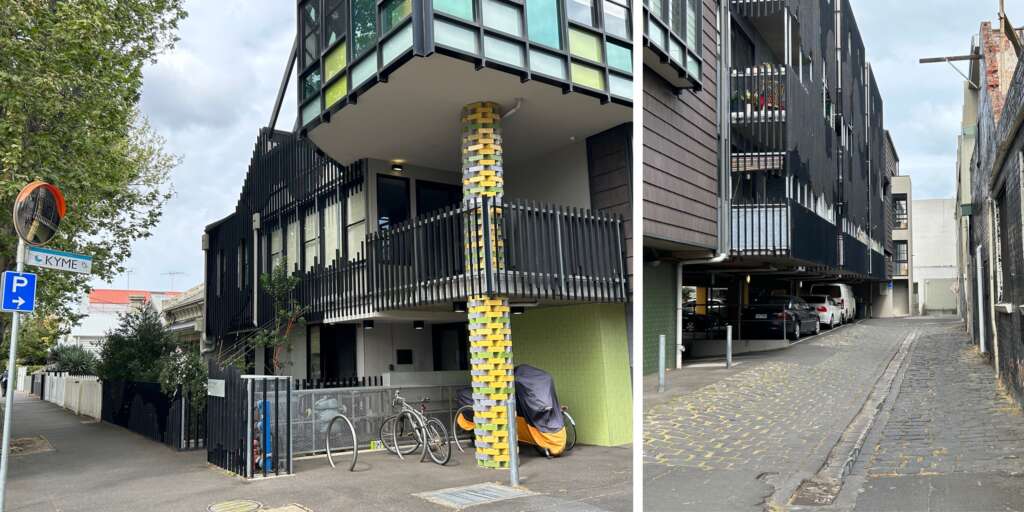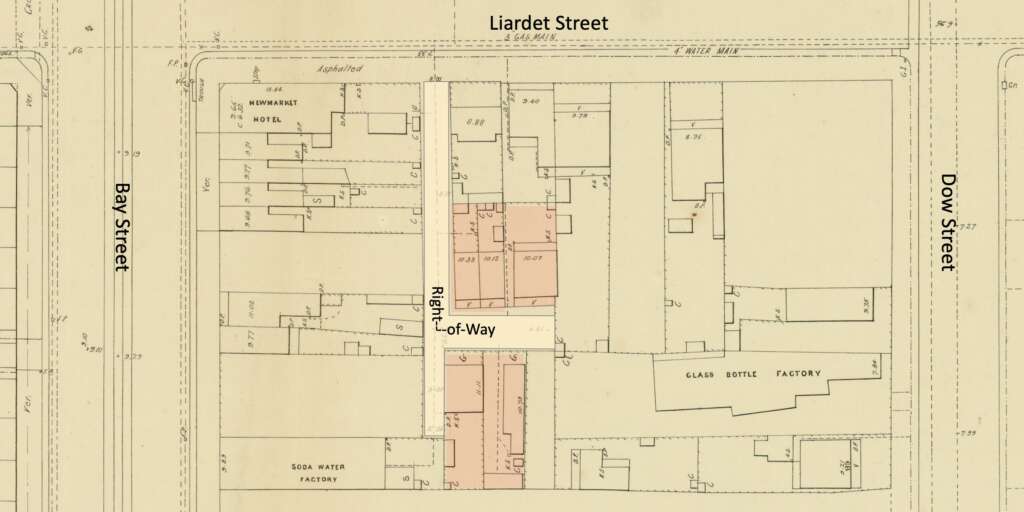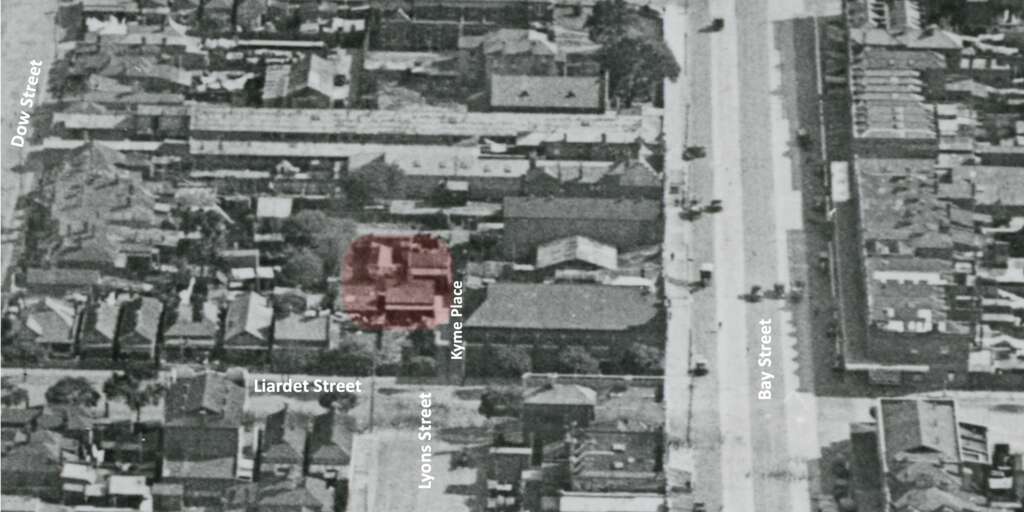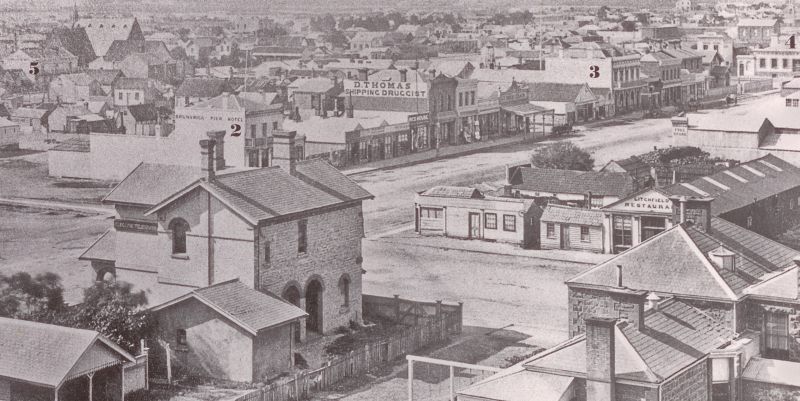Kyme Place
by David F Radcliffe
Kyme Place runs off Liardet Street behind the burnt-out old Port Melbourne Theatre. It provides access to the rear of commercial premises on Bay Street and a public parking garage. A distinctive building, also called Kyme Place, utilises the airspace above the car park. Constructed in 2012, it was designed by MGS Architects to provide self-contained apartments as well as socialisation areas for people who lack housing security.
Kyme Place is named after Charles Kyme who lived on this right of way for a dozen or so years. Born near Hull, England, Kyme came to Victoria around 1885, aged 53. A widower, he worked as a labourer and lived in West Melbourne. In 1887, he married thirty-year-old Ann Fieldsend, a domestic servant from Geelong. The next year, the couple settled in Port Melbourne where Kyme had purchased one of the houses at the back of the right-of-way. He worked as a laundryman. In 1897 he was called as a witness in the case of an indecent assault charge brought against John Guest.[1] The only other mention of Charles Kyme in the press of the day is that he was a competitive draughts player.[2] Around 1901 he moved to the Masonic home in Punt Road, Prahran. The naming of the right-of-way as Kyme Place coincided roughly with this move. Charles Kyme passed away in 1910 and Ann in 1917.
Why this right-of-way was named for the relatively obscure Charles Kyme and not someone who was a more public figure, or who had an earlier and more sustained association with the right-of-way is unknown. Why not Acheson Place?
Gilbert Acheson was one of those nominated for election to the first Sandridge council in July 1860.[3] He was unsuccessful but was nominated again in November of that year by James Garton for the casual vacancy caused by the resignation of Dr. Plumber.[4] Again he was unsuccessful as was his third attempt.[5] Notwithstanding these political setbacks, clearly, he was moving in the right circles.
Acheson had been granted his Hackney Cab licence in 1855.[6] By 1860 he owned 33 Liardet Street (later renumbered 121) which had a couple of 2-room cottages behind it that he rented out. Adjacent, there were a further three small cottages set back in the neighbouring allotment. Access to all these cottages off Liardet was via what became the right of way.
When Gilbert Acheson passed away in 1884 this property, and others he owned, went to his widow Annie who lived there until her passing in 1919. Another long-term resident, Mrs Margaret Lock, warranted an obituary in the Standard.[7] She lived there for 32 years from 1880, and was an immediate neighbour of Charles Kyme. In 1937 two houses in Kyme Place were declared unfit for human occupation and served with condemnation notices.[8]
The area began to be used for other purposes. Dugga Beazley recalls that his boat, the Pearl, was built there in 1940.[9] By then, one of the properties at the back of the lane was the site of the small factory that manufactured lead-based solder for use in plumbing.[10] A H Richards Pty Ltd, as it became, operated there until at least the 1970s. Their premises were not much more than a glorified galvanised iron shed.[11] Yet from these humble premises they fulfilled tenders for the Postmaster-Generals Department during the Second World War. Use of lead-based solder in pipes for drinking water was banned in the 1990s.
Walking by Kyme Place today, we are still left wondering: What was it about Charles Kyme and his standing in the neighbourhood that caused this right-of-way to be named after him?
[1] 1897 ‘GIRL ASSAULT.’, The Herald (Melbourne, Vic.: 1861 – 1954), 31 May, p. 1. , viewed 21 Sep 2023, http://nla.gov.au/nla.news-article241125812
[2] 1901 ‘Draughts.’, The Arena (Melbourne, Vic.: 1900 – 1903), 11 May, p. 19. , viewed 21 Sep 2023, http://nla.gov.au/nla.news-article255790122
[3] Nancy U’ren and Noel Turnbull, A History of Port Melbourne, Oxford University Press, 1983, p 49.
[4] 1860 ‘THE NEWS OF THE DAY.’, The Age (Melbourne, Vic.: 1854 – 1954), 28 November, p. 4. , viewed 21 Sep 2023, http://nla.gov.au/nla.news-article154883084
[5] 1862 ‘WEDNESDAY, SEPTEMBER 17, 1862.’, The Argus (Melbourne, Vic.: 1848 – 1957), 17 September, p. 4. , viewed 21 Sep 2023, http://nla.gov.au/nla.news-article5722202
[6] 1855 ‘CITY COUNCIL.’, The Age (Melbourne, Vic.: 1854 – 1954), 4 July, p. 4. , viewed 21 Sep 2023, http://nla.gov.au/nla.news-article154893382
[7] 1912 ‘Obituary.’, Standard (Port Melbourne, Vic : 1884 – 1914), 25 May, p. 2. , viewed 21 Sep 2023, http://nla.gov.au/nla.news-article165162620
[8] 1937 ‘PORT MELBOURNE COUNCIL’, Record (Emerald Hill, Vic.: 1881 – 1954), 13 March, p. 3. , viewed 21 Sep 2023, http://nla.gov.au/nla.news-article164481341
[9] Janet Bolitho, Personal Communication.
[10] John May, Personal communication.
[11] Glen Cosham, Personal communications.





